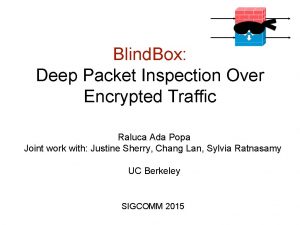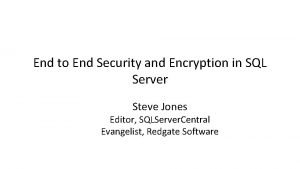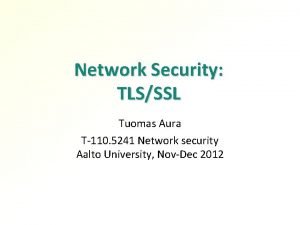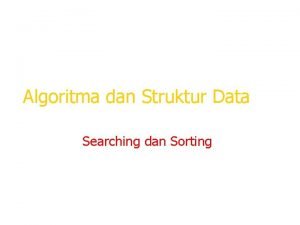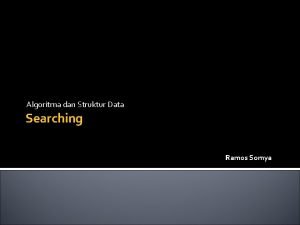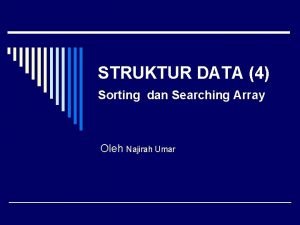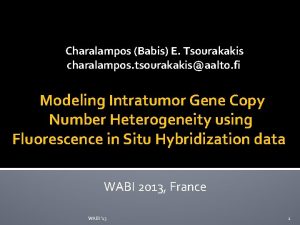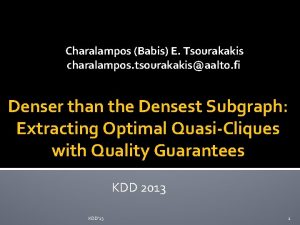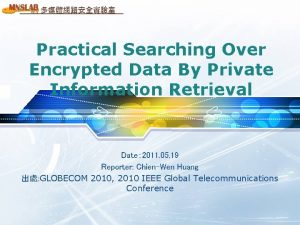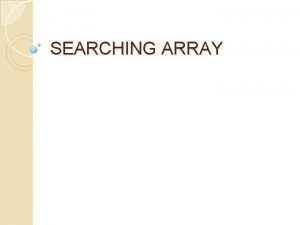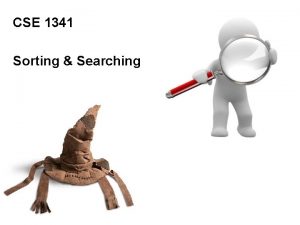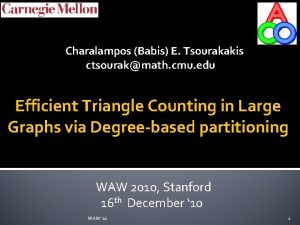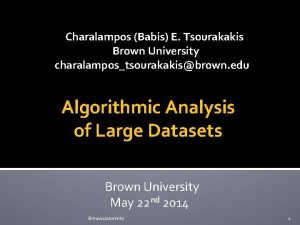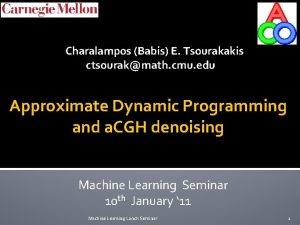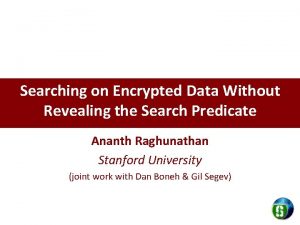Searching Over Encrypted Data Charalampos Papamanthou cpapumd edu















- Slides: 15

Searching Over Encrypted Data Charalampos Papamanthou cpap@umd. edu ECE and UMIACS University of Maryland, College Park Research Supported By

Cloud computing today Clients § Industries § Federal government § Universities PROVIDERS § Google § Yahoo! § Amazon

Is there any privacy? § Cloud provider uses its own keys to encrypt the clients’ data § So, rest assured…?

Where we want to get at in the future § We want clients to be in control of their data § Encrypt at the client’s machine § Cloud only gets to see the ciphertext! § Google and Yahoo! already moving forward with such an approach § See end-to-end (https: //github. com/google/end -to-end)

How about searching? § In theory possible, but impractical § Fully-homomorphic encryption § Oblivious RAM § Two-party computation § My group’s approach § Theory: Searchable encryption § Practice: Pmail (demo in the end)

Potential approaches fi yi = enc(fi) search All yi yi large bandwidth! fi yi = enc(fi) file id yid index large client space! yi

Searchable Encryption § § § fi First paper by Song, Wagner and Perrig in 2000 Encrypt files + index appropriately Search with encrypted tokens Return only the relative files Only for static indexes (or dynamic is not practical) yi = enc(fi) token t(w) yw yi index

Caveat • Searchable encryption leaks information – Search pattern – Access pattern

What is an index Microsoft F 2 F 10 F 11 Brown F 2 F 8 F 14 Berkeley F 1 F 2 Greece F 4 F 10 F 12 …(Microsoft, F 2), (Microsoft, F 10), …, (Brown, F 8), …, (Greece, F 4)….

What is a token • Definition of token for word w w K hash function tw Tokens are deterministic!

Basic scheme (NDSS 2014) initial index D (w, d) KEY = HASH(tw || count || 0 ) encoded hash table T (w, dꞌ)

Searching for keyword w • Client: Sends tw • Server: Looks up the entries mapping to tw – Learns nothing about keyword W tw

Updating the index • Important: Old tokens should not work for new files – Addressed in our NDSS 2014 paper

Research in my group • Searchable encryption with support for updates (CCS 2012, NDSS 2014) • Parallel algorithms for searchable encryption (FC 2013) • [Ongoing research] – [Theory] New searchable encryption schemes that • • are more expressive (range and conjunctive search) leak less information (eliminating search pattern leakage) support more efficient updates (improving the polylogn bound) use weaker cryptographic assumptions (removing the random oracle) – [Practice] Devoping Pmail (plugin for Gmail) • Pick the right SE scheme • Web security issues (how to integrate securely with Gmail API) • Usability issues (how can we design the interface so that more people can use it)

Pmail Demo
 Charalampos papamanthou
Charalampos papamanthou Qtbn
Qtbn Ssl/tls visibility
Ssl/tls visibility Deep packet inspection encrypted traffic
Deep packet inspection encrypted traffic Metadata of encrypted traffic analytics eta
Metadata of encrypted traffic analytics eta Row level encryption
Row level encryption Encrypted client hello
Encrypted client hello Algoritma searching dan sorting
Algoritma searching dan sorting Struktur data searching
Struktur data searching Pengertian searching dalam struktur data
Pengertian searching dalam struktur data Edu.sharif.edu
Edu.sharif.edu Hadoop hive architecture
Hadoop hive architecture Over the mountains over the plains
Over the mountains over the plains Siach reciting the word over and over
Siach reciting the word over and over Explain how to handing over and taking over the watch
Explain how to handing over and taking over the watch What is sequential search
What is sequential search



